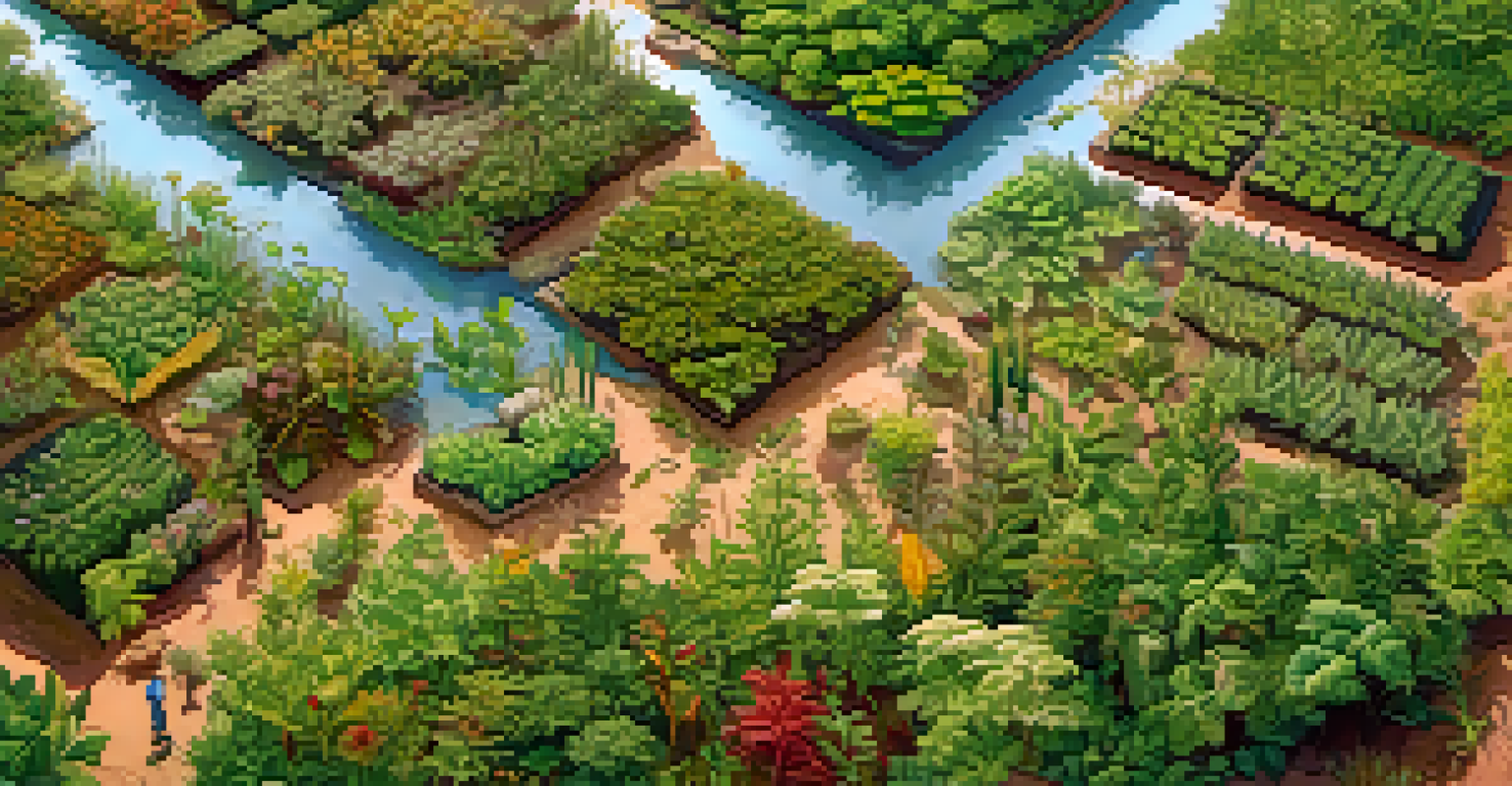Role of Herbivory in Shaping Plant Communities

What is Herbivory and Its Ecological Importance?
Herbivory refers to the consumption of plants by animals, and it plays a crucial role in ecosystems. This interaction not only affects the plants being eaten but also the overall structure and diversity of plant communities. By understanding herbivory, we gain insight into the delicate balance of nature and how different species influence one another.
Herbivores are the architects of our ecosystems, shaping the landscapes and communities through their feeding habits.
For instance, consider how grazers like deer or cattle can control the growth of certain plant species. When herbivores feed on dominant plants, it allows less competitive species to thrive. This dynamic can lead to a more diverse plant community, which in turn supports a wider array of animal species.
Ultimately, herbivory is not merely about the act of eating; it's a fundamental ecological process that shapes habitats and influences biodiversity. By examining these interactions, we can appreciate the intricate web of life and the importance of each species within it.
Types of Herbivores and Their Impact on Plant Communities
Herbivores can be categorized into different types: browsers, grazers, and frugivores, each impacting plant communities in unique ways. Browsers, like giraffes, typically feed on leaves and shrubs, shaping the structure of forests and savannas. Grazers, such as cows and sheep, primarily consume grasses, influencing grassland ecosystems significantly.

Frugivores, on the other hand, eat fruits and can aid in seed dispersal, thus affecting plant distribution and community composition. For example, when birds consume berries, they help spread seeds far and wide, allowing plants to colonize new areas. This kind of interaction enhances genetic diversity among plant populations.
Herbivory Shapes Ecosystem Diversity
Herbivory influences plant community structure and promotes biodiversity by allowing less competitive species to thrive.
Understanding these different types of herbivores helps us grasp their varying roles in ecosystems. Each type contributes to the balance of plant communities, ensuring that no single species dominates, which is essential for maintaining biodiversity.
The Balance of Herbivory: Too Much vs. Too Little
While herbivory is essential for shaping plant communities, there's a fine balance to maintain. Too much herbivory can lead to overgrazing, which devastates plant populations and disrupts the ecosystem. For instance, areas with high deer populations may experience a decline in certain plant species, leading to habitat loss for other wildlife.
The balance of nature is not a static situation; it is a dynamic, ever-changing state of interaction among living things.
Conversely, too little herbivory can also be problematic. When herbivores are absent, certain plants may become overly dominant, crowding out other species and reducing overall biodiversity. This phenomenon can be observed in protected areas where large herbivores have been removed, resulting in a shift in plant community structure.
Thus, the key lies in finding a balance where herbivory can promote diversity without causing harm. This understanding is crucial for effective wildlife management and conservation efforts aimed at sustaining healthy ecosystems.
Herbivory's Role in Nutrient Cycling and Soil Health
Herbivory also plays a significant role in nutrient cycling and maintaining soil health. When herbivores graze on plants, they not only consume nutrients but also contribute to the recycling of organic matter through their waste. This process enriches the soil, making it more fertile and conducive to plant growth.
For example, the droppings of large herbivores like elephants can introduce essential nutrients back into the soil, enhancing plant productivity. This nutrient cycling is vital for the sustainability of plant communities, as it supports a continuous growth cycle.
Balance in Herbivory is Crucial
Both excessive and insufficient herbivory can disrupt ecosystems, highlighting the need for a balanced approach to wildlife management.
Moreover, the physical act of grazing can stimulate plant growth. Many plants respond to herbivory by producing new shoots and leaves, which can lead to increased biomass and diversity. This intricate relationship between herbivores and plants underscores the importance of these interactions in ecosystem health.
Herbivory and Plant Defense Mechanisms
Plants have evolved various defense mechanisms in response to herbivory, which can significantly shape plant community dynamics. Some plants develop physical defenses, such as thorns or tough leaves, making them less palatable to herbivores. Others may produce chemical compounds that deter herbivores or attract predators of these animals.
For example, some species of sagebrush release volatile organic compounds when eaten, which attract insect predators that feed on the herbivores. This not only protects the plant but also enhances the overall health of the plant community by regulating herbivore populations.
These defense mechanisms create a fascinating dynamic between plants and herbivores. As herbivores adapt to overcome plant defenses, plants, in turn, evolve new strategies, highlighting the constant interplay between these two groups in shaping ecosystems.
The Influence of Climate Change on Herbivory and Plant Communities
Climate change is altering the patterns of herbivory and, consequently, plant community structures worldwide. Changes in temperature and precipitation can affect herbivore populations and their feeding behaviors, leading to shifts in grazing pressure on plant communities. For example, warmer temperatures may allow certain herbivores to expand their range, increasing their impact on newly accessible plant species.
Moreover, climate change can influence plant growth rates and nutritional quality, which in turn affects herbivore preferences. If plants become less nutritious due to stress from heat or drought, herbivores may switch to more palatable species, further altering community dynamics.
Climate Change Affects Herbivory
Climate change impacts herbivore populations and plant growth, altering grazing pressures and plant community dynamics.
Understanding these changes is critical for predicting future biodiversity patterns. As we navigate the effects of climate change, it becomes essential to consider how herbivory will continue to shape plant communities in a rapidly changing world.
Conservation Strategies: Managing Herbivory for Biodiversity
Effective conservation strategies must consider the role of herbivory in maintaining biodiversity. Management practices can include controlled grazing, reintroduction of native herbivores, and habitat restoration efforts. These strategies aim to create a balanced approach that fosters healthy plant communities while supporting herbivore populations.
For instance, in some national parks, regulated grazing is used to mimic natural herbivore patterns, allowing plant diversity to flourish while preventing overgrowth of dominant species. This not only benefits the plants but also enhances the overall ecosystem by supporting a diverse array of wildlife.

By understanding the intricate relationships between herbivores and plants, conservationists can develop targeted strategies that promote biodiversity. This holistic view is vital for sustaining ecosystems that are resilient to environmental changes.